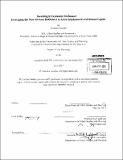| dc.contributor.advisor | Karl Seidman. | en_US |
| dc.contributor.author | Curella, Christine | en_US |
| dc.contributor.other | Massachusetts Institute of Technology. Department of Urban Studies and Planning. | en_US |
| dc.coverage.spatial | n-us-la | en_US |
| dc.date.accessioned | 2013-09-24T19:45:53Z | |
| dc.date.available | 2013-09-24T19:45:53Z | |
| dc.date.issued | 2013 | en_US |
| dc.identifier.uri | http://hdl.handle.net/1721.1/81147 | |
| dc.description | Thesis (M.C.P.)--Massachusetts Institute of Technology, Dept. of Urban Studies and Planning, 2013. | en_US |
| dc.description | "June 2013." Cataloged from PDF version of thesis. | en_US |
| dc.description | Includes bibliographical references (p. 66-71). | en_US |
| dc.description.abstract | Economic development projects too often fail to benefit neighborhoods of concentrated poverty and improve economic prospects for those who face barriers to employment. This thesis considers tools and strategies that city governments can use to leverage investments in economic development to achieve economic inclusion. The New Orleans BioDistrict has received more than $3 billion of investment and is expected to produce or retain 34,000 jobs over the next twenty years. An assessment of these jobs vis-a-vis adult education levels reveals that the skills required for these jobs exceed education levels of local residents. Other employment barriers include childcare and healthcare needs, transportation, and access to information. Equally significant barriers are employer hiring behaviors, which may exclude or bias hiring based on criminal record, place of residence, or the use of public assistance. All underscore the need for targeted efforts to connect local residents to the employment and educational opportunities created by the BioDistrict. Recommendations for New Orleans draw from local and regional economic analyses, as well as case studies of the Baltimore Alliance for Careers in Healthcare and the Baltimore Integration Partnership. Baltimore's experience indicates that sustained efforts and institutional commitment to economic inclusion can leverage investments in economic development to overcome employment barriers and increase local employment. To increase direct employment in the healthcare sector, the New Orleans workforce intermediary should provide additional supports to participants and employers to ensure training completion, and seek to leverage the current engagement of one firm to impact employment practices across the healthcare sector. To connect local residents to indirect employment, the BioDistrict and city government should use development incentives, requirements, and partnerships to drive commitments to local hiring; develop an external, neighborhood-based employment pipeline; and innovate and invest in adult education. | en_US |
| dc.description.statementofresponsibility | by Christine Curella. | en_US |
| dc.format.extent | 71 p. | en_US |
| dc.language.iso | eng | en_US |
| dc.publisher | Massachusetts Institute of Technology | en_US |
| dc.rights | M.I.T. theses are protected by
copyright. They may be viewed from this source for any purpose, but
reproduction or distribution in any format is prohibited without written
permission. See provided URL for inquiries about permission. | en_US |
| dc.rights.uri | http://dspace.mit.edu/handle/1721.1/7582 | en_US |
| dc.subject | Urban Studies and Planning. | en_US |
| dc.title | Investing in economic inclusion : leveraging the New Orleans BioDistrict to grow employment and human capital | en_US |
| dc.title.alternative | Leveraging the New Orleans BioDistrict to grow employment and human capital | en_US |
| dc.type | Thesis | en_US |
| dc.description.degree | M.C.P. | en_US |
| dc.contributor.department | Massachusetts Institute of Technology. Department of Urban Studies and Planning | |
| dc.identifier.oclc | 858401122 | en_US |
